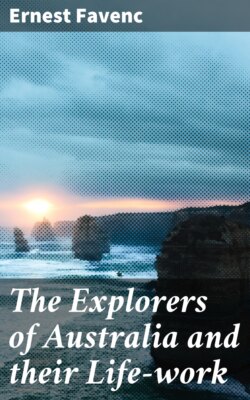Читать книгу The Explorers of Australia and their Life-work - Ernest Favenc - Страница 14
На сайте Литреса книга снята с продажи.
2.2. THE LACHLAN RIVER.
ОглавлениеEvans started from Bathurst on the 13th of May, 1815. He commenced his journey along the fine flat country then known as Queen Charlotte Vale, maintaining a southerly course for a day or two; but finding himself still amongst the tributaries of the Campbell River, he retraced his steps some twelve or fourteen miles in order to avoid a row of rocky hills. He then struck out more to the westward. On Thursday, the 23rd, he came to a chain of ponds bearing nearly north-west, and from a commanding ridge saw before him a prospect as gratifying as some of the scenes viewed on his former trip.
"I never saw a more pleasing-looking country. I cannot express the pleasure I feel in going forward. The hills we have passed are excellent land, well-wooded. To the south, distant objects are obscured by high hills, but in the south-west are very distant mountains, under them appears a mist as tho' rising from a river. It was the like look round to the west, but beyond the loom of high hills are very faintly distinguished."
This was the first view Evans obtained of the Lachlan valley. The ponds he had met with gradually grew into a connected stream: other ponds united with them from the north-east, and he writes: "they have at the end of the day almost the appearance of a river." On the 24th he came to a creek which joined "the bed of a river rising in a North 30 East direction, now dry except in hollow places. It is fully 70 feet wide, having a pebbly bottom; on each side grow large swamp-oaks."
On Thursday, the 1st of June, this river holding a definite course to the westward, and he being clear of the points of the hills, which hitherto had hindered him greatly, he determined to return, as he was running short of provisions.
"To-morrow I am necessitated to return, and shall ascend a very high hill I left on my right hand this morning. I leave no mark here more than cutting trees. On one situated in an angle of the river on a wet creek bearing north I have deeply carved EVANS, 1st JUNE, 1815."*
*[Footnote.] This tree, a tall and sturdy gum, flourished for over ninety years, and when in its prime was, unfortunately, owing to the spread of agricultural settlement, inadvertently ring-barked and killed. It must have been a fine tree when marked by the explorer, and though dead it is still standing at the date of the publication of this book. In 1906, the shield of wood bearing the inscription, was cut off by Mr. James Marsh, of Marshdale, and is now preserved in the Australian Museum in Sydney, New South Wales. It is the oldest marked-tree in the whole of Australasia.
On the next morning Evans ascended the hill he alluded to, and from the summit enjoyed a most extended view of the surrounding country, which he compared to a view of the ocean. On his way back to Bathurst, he bestowed upon the new river the name it now bears. A short passage in his diary, written during his return, is of peculiar interest, as it contains the first mention of snow seen in Australia by white men. On Thursday, the 8th of June, he writes:--
"The mountains I observed bearing north-west are covered with snow; I thought on my way out that their tops looked rather white. To-day it was distinguished as plain as ever I saw snow on the mountains in Van Diemen's Land. I never felt colder weather than it has been some days past. We have broken ice full two inches thick."
On the 12th of June the party returned to Bathurst, and Evans had by that time accomplished two of the most momentous journeys ever made in Australia. It was not his actual discoveries alone that brought him fame, but the vast field for settlement these discoveries opened up. The independent explorations of Surveyor Evans ceased after his discovery of the Lachlan; thenceforward he served Australia as second to Lieutenant Oxley.
